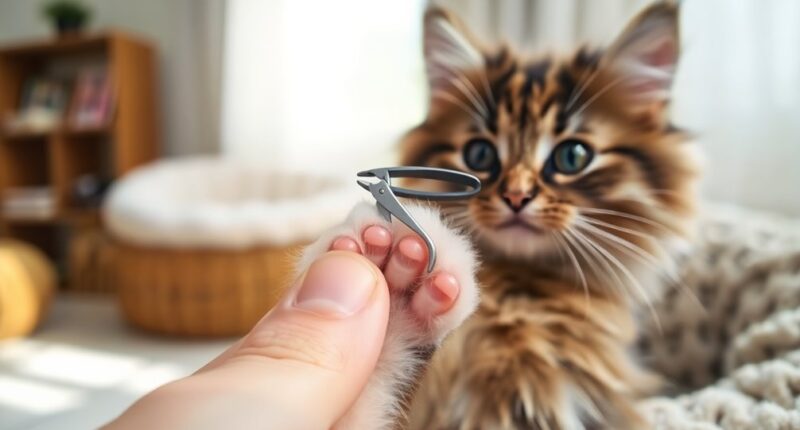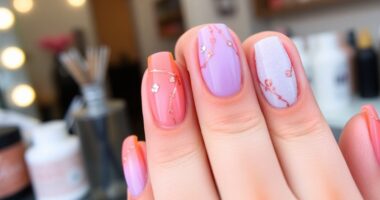To cut your cat's nails, start by getting them comfortable with paw handling. Use quality clippers, like scissors or guillotine-style, and gather tools like treats and styptic powder. Secure your cat in a calm environment, press on their paw pads to extend claws, and trim just the tip at a 45-degree angle. Remember to reward your cat after each nail. For a more thorough process and tips for a stress-free experience, keep exploring!
Key Takeaways
- Gradually acclimate your cat to paw handling and clippers using positive reinforcement to reduce fear and anxiety.
- Use high-quality nail clippers and have styptic powder ready for any accidental bleeding during trimming.
- Ensure a calm environment, and secure your cat gently while extending claws for trimming at a 45-degree angle.
- Trim only the sharp tip of the claw, avoiding the quick, and reward your cat after each nail for positive reinforcement.
- Check for bleeding post-trimming, apply styptic powder if necessary, and schedule regular trimmings every 1.5 to 2 weeks.
Preparing Your Cat for Nail Trimming

Before you start trimming your cat's nails, it's essential to help them feel comfortable with the process.
Begin by preparing your cat to have its paws handled for a few seconds each day, gradually increasing the time. This builds trust and familiarity.
Place the nail clippers in a visible area, allowing your cat to explore them, which reduces fear of the tool.
Use positive reinforcement—treats or praise—whenever your cat lets you touch its paws or the clippers.
To familiarize your cat with the clipping sound, simulate the action on a dry spaghetti noodle, rewarding them for staying calm.
Practice gentle restraint by holding your cat securely in your lap or on a flat surface, creating a safe environment for nail trimming. Additionally, ensure that your cat is in a calm state to help facilitate a smoother nail trimming experience.
Essential Tools for Trimming Cat Nails
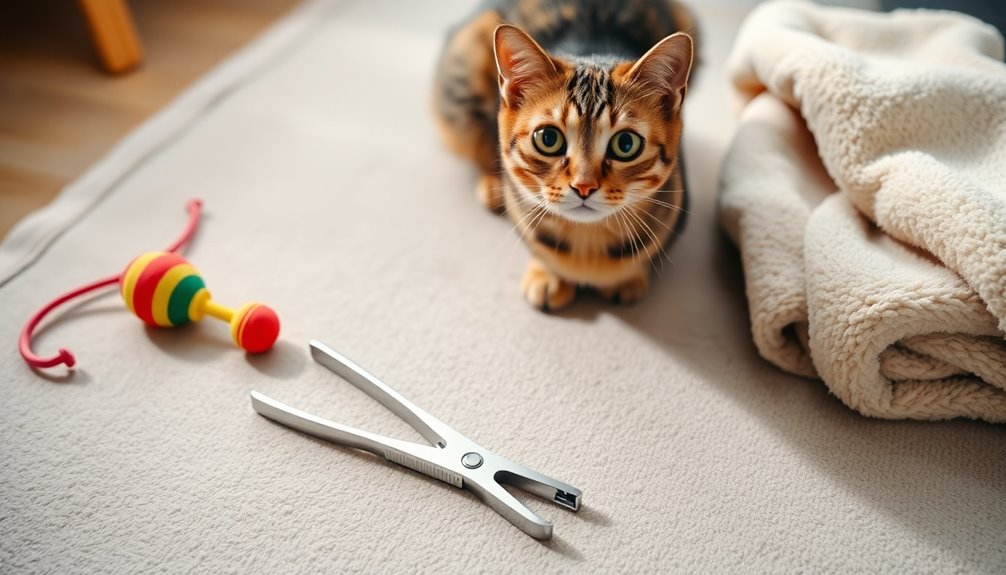
- High-quality nail clipper: Choose between scissors, pliers-like clippers, or sliding guillotine blades to find what works best for you.
- Styptic powder: Always have this on hand to quickly address any accidental bleeding if you accidentally trim too far.
- Towel: Wrapping your cat in a towel can help keep them secure and calm during the trimming process.
- Calibrated lighting can also help create a relaxed environment, ensuring your cat feels more comfortable during the nail trimming session, similar to how lighting control is crucial for optimal image quality in home cinema setups.
Step-by-Step Nail Trimming Process
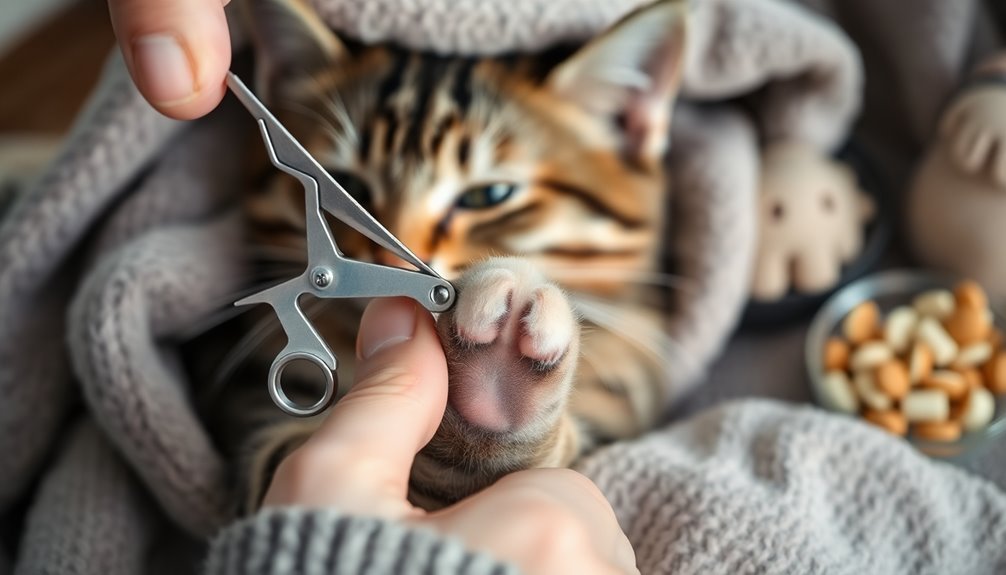
Now that you've got your tools ready, it's time to prepare for the actual nail trimming.
You'll want to make certain your cat is comfortable and relaxed before you start clipping.
Let's go over the safe clipping techniques and what to do afterward for the best experience. Remember, regular trimming helps prevent breakage and damage to your cat's nails.
Preparing for Nail Trimming
Preparing your space for nail trimming is essential to guarantee a smooth experience for both you and your cat. Start by gathering everything you'll need, ensuring you're prepared for the nail clipping process. Create a calm environment to help reduce stress.
Here are some key items to have ready:
- A sharp nail trimmer
- Treats for positive reinforcement
- Styptic powder or cornstarch in case of bleeding
Before you trim your cat's nails, gently hold the cat while familiarizing them with paw handling. Allow them to investigate the clippers, using a dry spaghetti noodle to mimic the sound.
When it's time to trim, hold the cat securely, press on the pad to extend the claw, and reward them after each nail.
Safe Clipping Techniques
With your cat calm and comfortable, it's time to start the nail trimming process. Gather your supplies—sharp nail trimmer, styptic powder, and treats.
Choose a quiet space to help reduce stress for both of you. Position your cat in your lap or on a table, gently pressing on the joint behind each claw to extend it.
For a safe nail trim, cut only the sharp tip of the claw at a 45-degree angle, avoiding the pink part, or quick, to prevent bleeding and pain. Aim to have your cat's nails trimmed every week for maintenance. Regular nail trims can help prevent severe hearing loss in pets that may be sensitive to loud noises.
Reward your cat with treats and praise after each nail trimmed, reinforcing positive behavior and making future sessions easier.
Post-Trimming Care Tips
Once you've trimmed your cat's nails, it's essential to provide proper post-trimming care to guarantee their comfort and reinforce the positive experience.
Start by inspecting the cat's paws for any signs of bleeding or discomfort. If you notice any issues, apply styptic powder or cornstarch to stop the bleeding.
Next, reward your cat with a treat to create a positive association with the process.
- Gently massage the cat's paws to soothe them.
- Keep an eye on their behavior for the next few hours to confirm they're comfortable.
- Don't forget to schedule the next trimming session every 1.5 to 2 weeks to maintain nail health. Additionally, regular nail trimming can help prevent common health concerns such as nail overgrowth or injury.
Your cat will appreciate your care!
Tips for a Stress-Free Experience
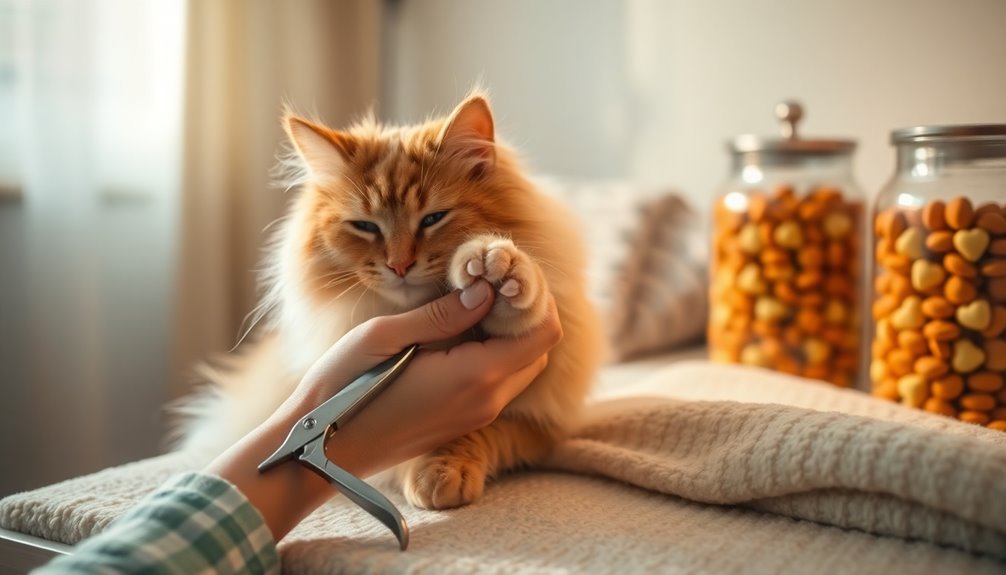
To guarantee a stress-free experience when cutting your cat's nails, create a calm environment by choosing a quiet spot for the task.
Spend a few minutes each day familiarizing your cat with paw handling and the nail clipper. This builds trust and comfort before you start trimming their nails.
During the process, use positive reinforcement like treats and praise after each nail is trimmed, helping your cat associate the experience with something rewarding.
If your cat shows signs of distress, take a break to allow them to relax. Remember, it's okay to limit the trimming to just a few nails at a time.
Gradually working towards trimming all nails can make the experience more manageable for both of you. Additionally, incorporating positive reinforcement techniques can significantly enhance your cat's comfort during nail trimming sessions.
Understanding Nail Growth and Maintenance
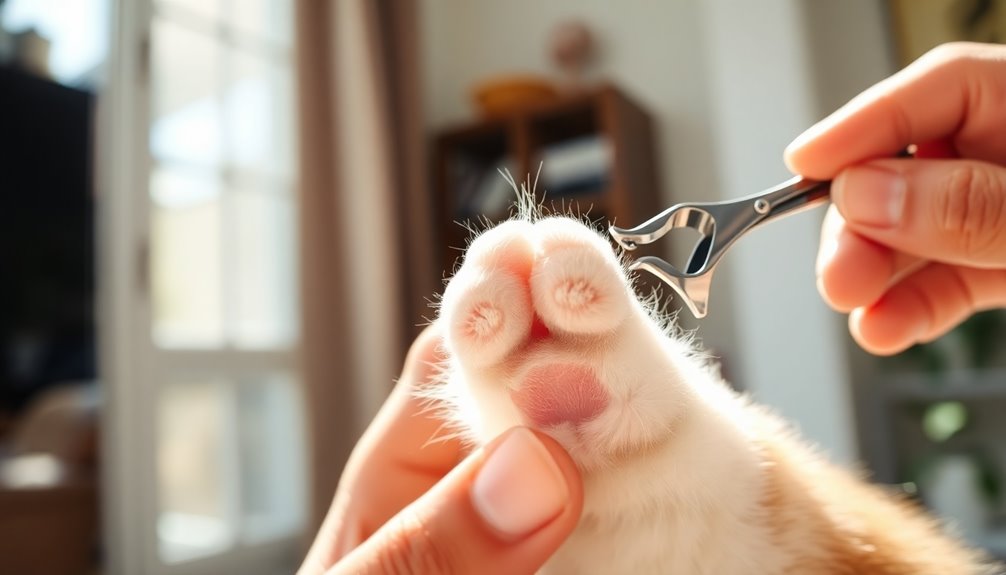
Understanding your cat's nail growth and maintenance is essential for their well-being. Cat nails grow continuously, and it's important to clip the nails regularly to prevent overgrowth.
For indoor cats, you'll typically need to trim their claws every two to three weeks. Kittens may require weekly trims, while older cats might only need it once a month.
Keep an eye out for signs of overgrown nails, such as:
- Difficulty retracting claws fully
- Excessive curvature of the nail
- Sharp tips that can cause injury
Regular maintenance helps avoid painful overgrowth and potential infections from broken or split nails. Additionally, establishing a consistent routine for nail trimming can make the process easier for both you and your cat.
Alternatives to Declawing and Nail Covers
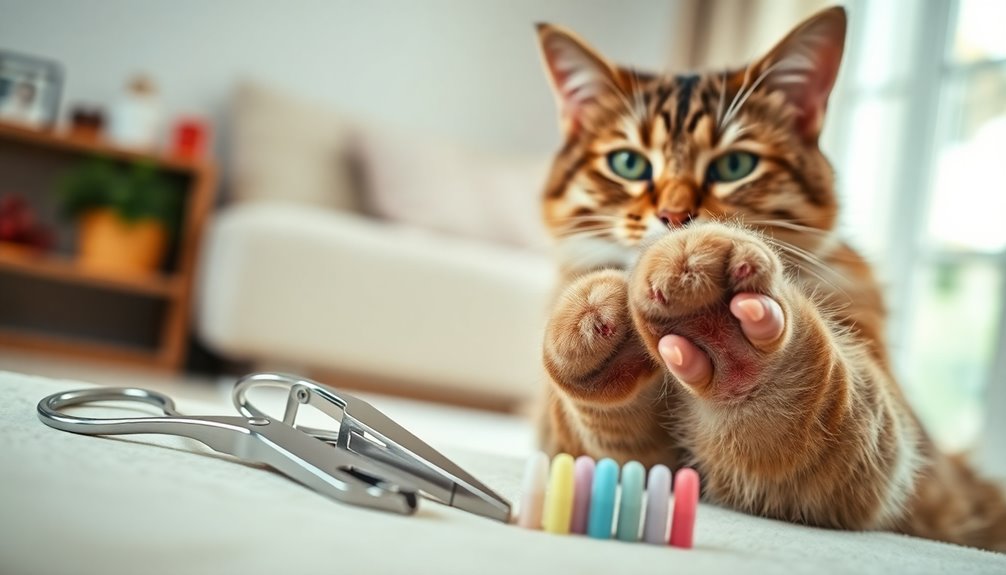
While declawing might seem like an easy solution to manage scratching behavior, it's often harmful and unnecessary. Instead, consider non-invasive alternatives like nail covers, such as Soft Paws, which can protect your furniture while keeping your cat comfortable.
Regular nail trimming every 1.5 to 2 weeks is essential for maintaining manageable nail length and minimizing scratching. Additionally, providing scratching posts and pads encourages your cat to engage in their natural behavior while preserving their claws. Montessori toys can also promote creative play, which can be a great distraction for your cat.
These strategies not only protect your home but also guarantee your cat stays healthy and happy. Don't hesitate to consult with your veterinarian about nail covers and other alternatives to find the best solution for both you and your feline friend.
Frequently Asked Questions
How Do I Cut My Cat's Nails by Myself?
To cut your cat's nails by yourself, start by gathering your supplies like sharp clippers and treats.
Find a quiet spot where your cat feels secure. Hold them gently in your lap or on a stable surface.
Extend their claws by pressing on the joint, then trim just the sharp tip.
Remember to take breaks if they get stressed, rewarding them with treats afterward.
Stay calm, and you'll both feel more relaxed during the process.
How Do You Trim an Unwilling Cat's Claws?
When you're dealing with an unwilling cat, it's crucial to create a calm environment.
Try wrapping your cat in a towel to limit sudden movements. If possible, enlist a helper to hold your cat securely or distract it with treats.
Focus on one nail at a time and take breaks if your cat seems agitated.
Is It Necessary to Trim a Cat's Claws?
Imagine a tree with branches growing wild—just like your cat's claws, they need attention.
Yes, it's necessary to trim your cat's claws. Regular trimming prevents overgrowth that can lead to discomfort and injury.
Think of it as nurturing a garden; it keeps your feline friend healthy and happy.
What to Do if Your Cat Won't Let You Cut Their Nails?
If your cat won't let you cut their nails, try taking a step back and reassess the situation.
Gradually acclimate them by handling their paws more often and rewarding them with treats. You might want to involve a helper to gently hold or distract your cat.
Break the trimming into small sessions, focusing on just one or two nails at a time, and always guarantee the experience remains positive to build trust.
Conclusion
In summary, trimming your cat's nails doesn't have to be an intimidating task. With the right tools and a little patience, you can turn nail trimming into a bonding experience rather than a battle. Remember, regular maintenance keeps your cat comfortable and your furniture safe. Like a well-tuned instrument, a little care goes a long way in ensuring that your feline friend stays happy and healthy. So grab those clippers and get started!
